Anchorage's 4th Avenue Theatre still standing, fate uncertain
How many bad breaks can one monumental building take before it ceases to exist? This is the essential question many of us are asking, watching helplessly as this once grand colossus of the frontier continues its long sleep, boarded up and falling apart on our city's historical main drag.
Captain Lathrop
When Austin E. "Cap" Lathrop envisioned his new movie palace in the late 1930s, fresh after completion of a fairly grand one in Fairbanks, Anchorage was the fourth-largest city in Alaska, population 4,000 -- less than half as many as Fairbanks and a bit fewer residents than either Juneau or Ketchikan. It would grow, most rapidly in the '50s and '60s and steadily since then into its 2018 version, wall-to-wall sprawl, pop. 300,000 nestled between Cook Inlet and the Chugach Mountains, the major metro area in a state of 750,000, with Fairbanks now a distant second.
Lathrop's business ventures were intense and varied. He came to Alaska in the first place as a steamship captain out of Seattle in 1895, making repeated trips delivering gold miners and other speculators and their provisions and equipment to the town of Hope in Turnagain Arm, a bit south of the future site of Anchorage. Later in Valdez, Alaska in the early 20th century he made a small fortune in road construction work. His most lucrative work related to real estate and mining. He was an old school magnate, giving back to the place that had bestowed wealth and fortune upon him -- in contrast to today's one percenters, most of whom apparently intend to take it with them.
In 1923 Lathrop financed production of a Hollywood silent movie, The Cheechacos. Though it was a B-grade melodrama and not critically acclaimed, it's notable for being filmed in Alaska. The outdoor scenes were filmed on Turnagain Arm and the town of Girdwood, then a mining town on the opposite side of the arm from Hope, and now part of Anchorage and home to a downhill ski resort. A screening of a refreshed version of the film, with orchestral accompaniment at the Alaska Center for the Performing Arts downtown was well-attended by the local artistic and philanthropic community in 2015.
Lathrop built his first Anchorage movie house in 1916, the year after the new Anchorage town site's creation. His vision for the second one was large. Lathrop hired noted Northwest theater architect B. Marcus Priteca to design it. Construction began in 1941, and after a lengthy delay associated with World War II, finally opened to the public in 1947. Though not as elaborate as many of Priteca's west coast theaters for Pantages and other clients, for a town of fewer than 5,000 a world class movie house with a beautifully decorated auditorium, lobby and balcony and 1,100 seats must have been a thoroughly unanticipated development. A miracle that it happened at all.
B. Marcus Priteca
The 4th Avenue came along 30 years into Priteca's career, at a time when tastes were changing. The exterior takes on more of an art deco/art moderne treatment than his previous designs. The street level facade on 4th Avenue is Italian marble with a jade base. The lobby includes a grand staircase to the balcony, past a wall of hardwood millwork panels accented by neon backlighting. There's a mixture of wood wall treatments, custom made acrylic deco style light fixtures and curved coffered ceilings; all revealed after passing the ticket window and the second set of three heavy mahogany framed leaded glass doors swinging on heavy brass pivot hinges. All of the original interior materials were first rate, from the plaster and gold leaf frescoes depicting the history of post-Industrial age Alaska, the high grade seat fabrics and carpet to the marble toilet partitions. The main auditorium has a sloped floor, with a wood molding proscenium and red velvet curtain framing the screen.
There was also a full basement, utility spaces and two upper floors of offices wrapped around one side of the auditorium and above the balcony lobby.
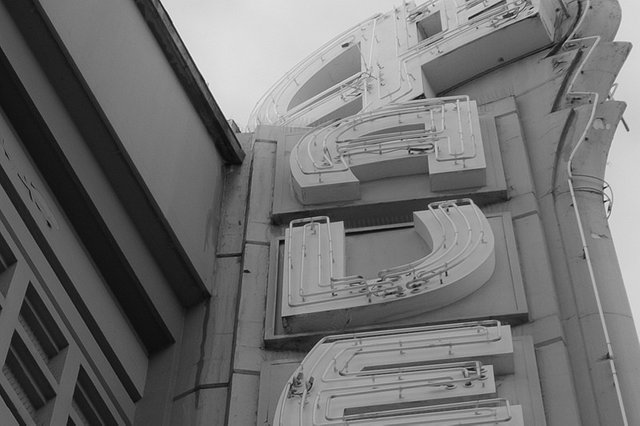
Crown jewel of Anchorage takes only minor abuse
It was the only real movie theater in the classic American idiom that Anchorage ever had. Lathrop's previous Anchorage theater, the Empress was smaller and simpler. And all of the other local movie houses since the 4th Avenue were either spartan or super tacky, albeit functional. The one exception, where greater care was taken in concept and execution is the Bear Booth Theatrepub, a 1990s conversion of one of the '60s lackluster theaters into a neat pizza restaurant and brewpub, with two attached restaurants. They show first- and second-run movies, art films and performances and other events. It's been a gold mine for its owners, crowds packed in every night in its two decades plus of operation; an astonishingly successful local business in the independent restaurant field that's typically extremely difficult and unforgiving. The pizza and beer are fantastic, the foundation of the operation. One would think they'd be an obvious choice to take over the 4th Avenue? They do not seem interested, though.
Lathrop died in 1950, aged 85, a scant three years into operation of the 4th Avenue. He had no heirs, though his business successors continued to operate his statewide theater chain and manage his other holdings for a few years until they were gradually divested. A series of changes Lathrop wouldn't have liked ensued at the 4th Avenue. Concession stands -- Lathrop did not permit them -- were bootlegged into the main lobby and balcony lobby. A penthouse apartment was constructed on the roof -- ultra cool in its own way but not really compatible. A radio broadcast antenna and then one for a TV station were added -- then removed after the stations relocated. Signs that weren't part of the original came and went. A 10 foot wide gap on one side of the building was covered with a roof to turn it into a breezeway.
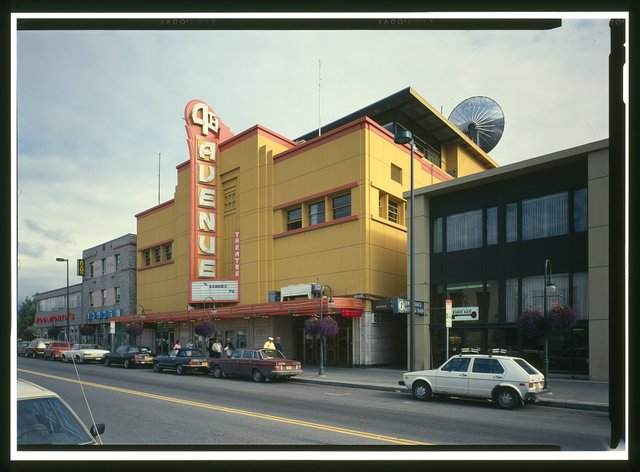
It's rumored that Lathrop's ghost haunts the basement. Evidence of paranormal activity notwithstanding, for the most part Lathrop has remained silent after his death, although he does occasionally post to his Facebook page.
Through all this, the 4th Avenue continued to operate as a first run movie house until 1985, when it was converted into use as a performance space temporarily, while the Alaska Center for the Performing Arts nearby was under construction.
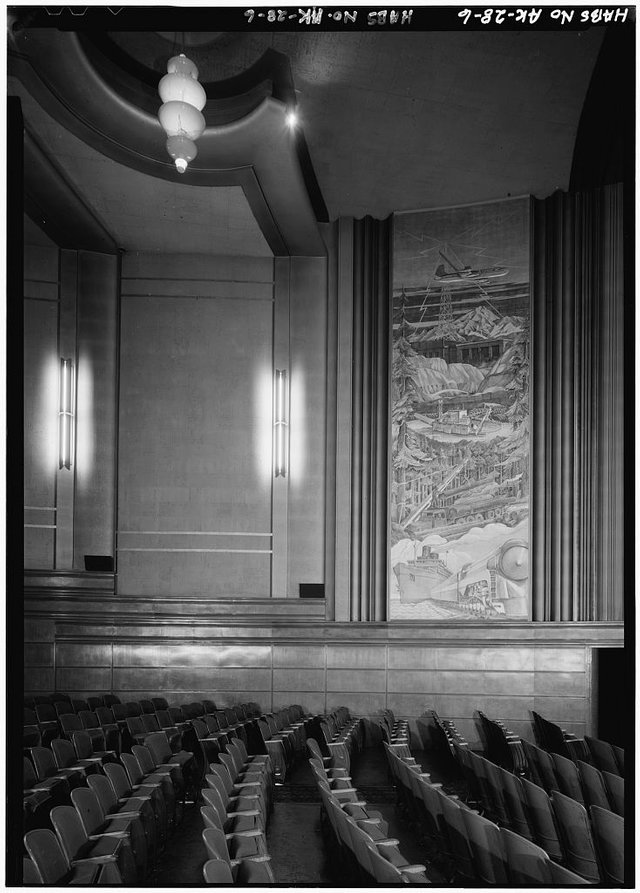 Side wall of the auditorium. HABS/HAER photo, 1985.
Side wall of the auditorium. HABS/HAER photo, 1985.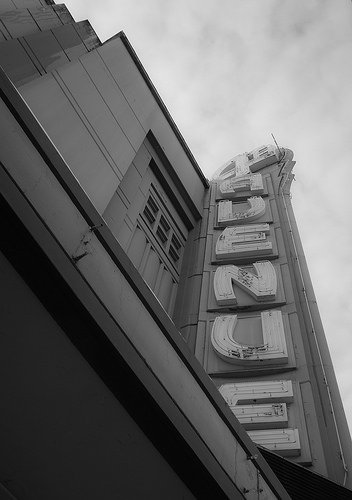 Looking up at the marquee. It's impressive, but so is the auditorium. Photo: Clark Yerrington, 2018.
Looking up at the marquee. It's impressive, but so is the auditorium. Photo: Clark Yerrington, 2018.
The later incarnations
In the late '80s through the '90s the building was owned by Robert Gottstein, grandson of an early Anchorage merchant businessman who today continues to manage his family's businesses. Gottstein's idea was to operate the theater as a special events hall, conduct tours and use it as headquarters for a food catering company. He sold the building to the current owners, Peach Investment Corp., 2004-ish, somewhat under financial duress. In recent years he's been a vocal critic of current stated plans for the building, believing that preservation is the best way forward and that the building has adequate rental office potential to provide for its ongoing maintenance, even lacking a concrete plan for use of the main auditorium.
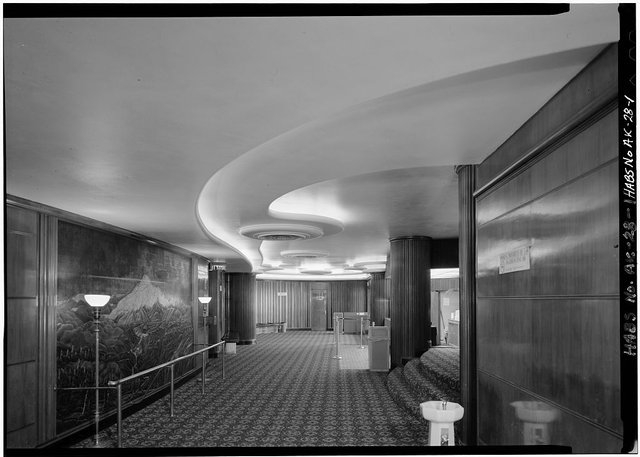 Theater lobby. HABS/HAER photo, 1985.
Theater lobby. HABS/HAER photo, 1985.Some remnants of the 1985 conversion still remain inside. The original theater seats were removed and the sloped floor was over-framed with a flat floor, for greater utility and access -- but done in such a way that it didn't damage any of the original interior finishes.
Present malaise
The same San Francisco area-based family group that owns Peach Investment Corp. built a mid-rise office tower in Midtown Anchorage in 2007, and they also own other local property. Another holding of theirs, a long derelict eight story abandoned hotel a few blocks west of their new tower was finally torn down in 2017. For a while, the fate of the theater and the derelict hotel seemed to be intertwined. Peach applied for demolition permits for both of them on the same day. It seemed like it was posturing more than anything, and that they did not really intend to demolish the theater. Like many developers, they perceive an opportunity to negotiate tax breaks and other concessions with city government.
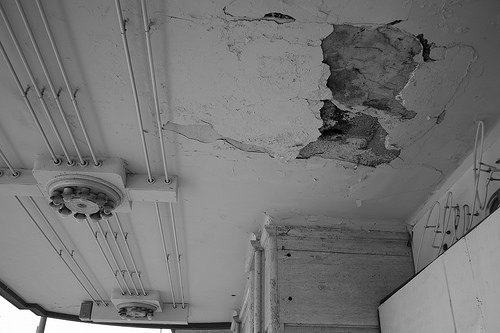 Crumbling canopy roof above the sidewalk on 4th Ave. Photo: Clark Yerrington, 2018.
Crumbling canopy roof above the sidewalk on 4th Ave. Photo: Clark Yerrington, 2018.Peach's past proposal for the theater, also involving adjoining lots on the same block was an ambitious, forward thinking concept, including a condo tower, office and retail. It's believed to be no longer in play, as right after it was made public in 2015 the state of Alaska entered a budget and financial crisis that is ongoing.
"This Save the Facade thing is kind of getting out of hand!" reads a 2015 social media post from a Seattle architectural firm I follow, commenting on Seattle area proposals as well as similar projects worldwide. Developers continue to propose these, hoping to convince segments of the public that it represents a partial win, if elements of notable historic buildings are preserved as part of a new development. Many are skeptical, myself among them. The practice is referred to as facadism, or in more extreme cases where there is little or no connection between the original and the new building, facadomy. As painful as it would be to witness, I'd rather see the 4th Avenue Theatre pounded into sand than be humiliated by turning its street face and lobby into a grille for a condo block. I'm more imaginative than many of my friends and colleagues, but there is a limit to it.
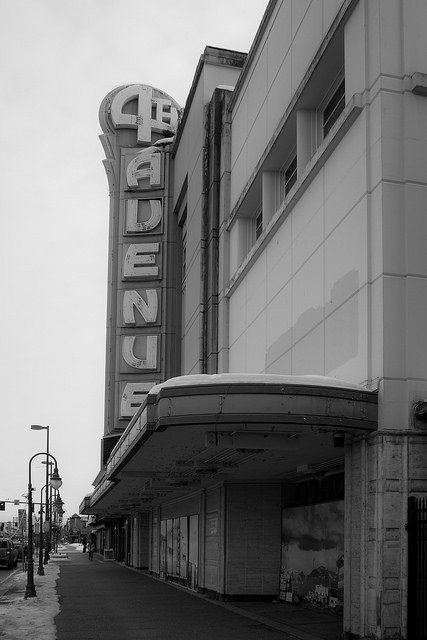 Street view, NW exterior. Photo: Clark Yerrington, 2018.
Street view, NW exterior. Photo: Clark Yerrington, 2018.Conclusions
It's rumored that Peach is gradually coming to understand the theater is a widely beloved local landmark, among those with past experience with it. Meanwhile the current Anchorage general public has lost touch with it, since it has been closed for the better part of two decades. The inside is apparently still in reasonable condition, and local officials have been allowed inspection tours periodically. I agree wholeheartedly with Gottstein, that one should not need a complete operational plan in place in order to identify preservation as the overarching goal. We should form a pathway to work with the owners toward those ends, in a way that ties government support to covenants that will prevent demolition or modification of the important historic features.
We need to catch a break with this place. It's part of the maturation process for our 103 year old city to start to value our historic resources more than we used to. Seattle came alarmingly close to demolishing the Pike Place Market in the '50s. It was considered an anachronism in the modern age of gleaming suburban supermarkets, amid an atmosphere of upheaval and disdain for traditional development patterns. Then they came to their senses and realized what a treasure the place actually is.
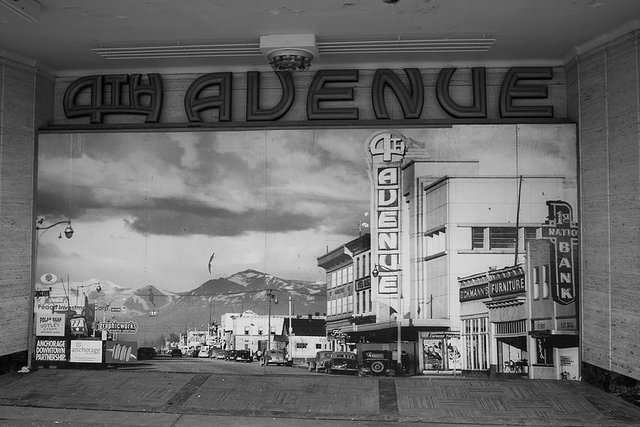 The shuttered main entry is decorated with a historic photo of the theater in happier times. Photo: Clark Yerrington, 2018.
The shuttered main entry is decorated with a historic photo of the theater in happier times. Photo: Clark Yerrington, 2018.
Congratulations @futureclark! You have completed some achievement on Steemit and have been rewarded with new badge(s) :
Click on any badge to view your own Board of Honor on SteemitBoard.
For more information about SteemitBoard, click here
If you no longer want to receive notifications, reply to this comment with the word
STOPCongratulations @futureclark! You have completed some achievement on Steemit and have been rewarded with new badge(s) :
Click on any badge to view your own Board of Honor on SteemitBoard.
For more information about SteemitBoard, click here
If you no longer want to receive notifications, reply to this comment with the word
STOPCongratulations @futureclark! You received a personal award!
You can view your badges on your Steem Board and compare to others on the Steem Ranking
Do not miss the last post from @steemitboard:
Vote for @Steemitboard as a witness to get one more award and increased upvotes!